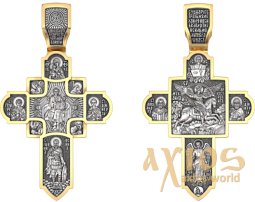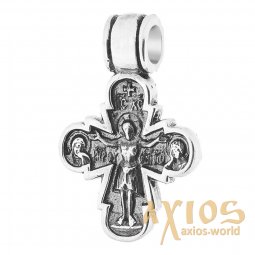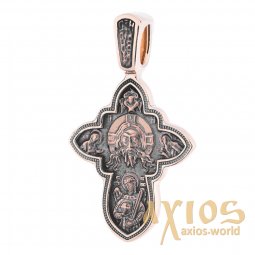Material: 925◦ silver, 999◦ gold plated
Average weight: 10.5 grams
Size: 39*22mm
Technique: casting, gilding, blackening, handmade.
On the front side, according to tradition, the Crucifixion of the Lord Jesus Christ is depicted. The reverse side of the cross is dedicated to the twelfth holiday. The Twelfth Feasts are the twelve most important holidays in Orthodoxy after Easter. Devoted to the events of the earthly life of Jesus Christ and the Mother of God, they are among the great holidays.
The Exaltation of the Holy and Life-Giving Cross of the Lord is a holiday established in memory of the finding of the Cross of the Lord, which, according to church tradition, took place in 326 in Jerusalem near Mount Calvary, the place of the Crucifixion of Jesus Christ. Since the 7th century, the memory of the return of the Life-Giving Cross from Persia by the Byzantine emperor Heraclius (629) began to be connected with this day. The name of the holiday is due to the custom of the Church in the East, dating back to the 4th century, to ritually erect a cross during worship (that is, raise the Cross for viewing by all those who pray)
The cross was found by the mother of Emperor Constantine the Great, Empress Helen, who arrived in Palestine, and the Jerusalem Bishop Macarius (314-333). As a result of the excavations, the cave of the Holy Sepulcher was found, and not far from it, three crosses were discovered. The cross of Jesus Christ was determined when the sick woman, on whom they were laid in turn, received healing. According to another legend, from contact with this cross, the deceased was resurrected, who was carried down the street for burial (hence the name Life-Giving Cross).
Empress Elena marked the places connected with the earthly life of the Savior, the foundation of more than 80 churches erected in Bethlehem - the place of the Nativity of Christ, on the Mount of Olives, from where the Lord ascended to heaven, in Gethsemane, where the Savior prayed before his sufferings and where the Mother of God was buried. Emperor Constantine ordered the erection in Jerusalem of a majestic and vast temple in honor of the Resurrection of Christ, which included both the Holy Sepulcher and Golgotha. The temple was consecrated on September 13, 335. The next day, September 14 (27), it was established to celebrate the Exaltation of the Holy and Life-Giving Cross.
“Save, O Lord, Thy people, and bless Thy inheritance, granting victory to the opposing, and keeping Thy habitation by Thy Cross” (Troparion of the Cross, tone 1)








